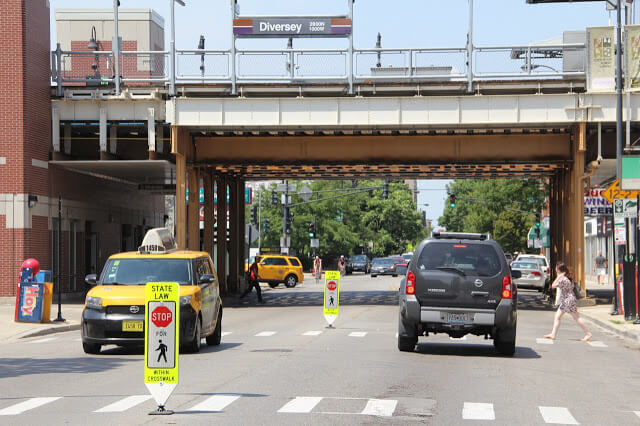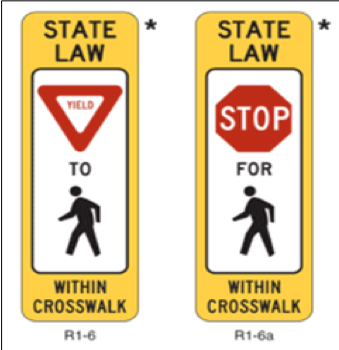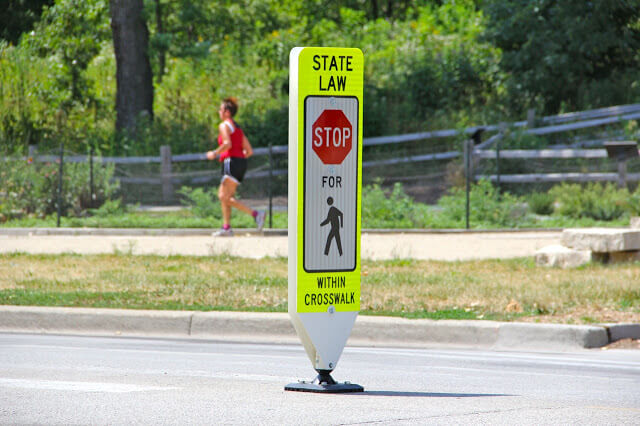NJLTAP Enews Volume 20 – Issue 4 – July/August 2018
By Becky Crowe, FHWA Office of Safety
The FHWA has been promoting the Safe Transportation for Every Pedestrian (STEP) program to address pedestrian safety at uncontrolled crossing locations by promoting crosswalk visibility enhancements, raised crosswalks, pedestrian refuge islands, pedestrian hybrid beacons (PHBs), and Road Diets.
State DOTs and local agencies are partnering with FHWA to advance STEP, and together they are rolling out a variety of low-cost improvements to supplement proven countermeasures and increase pedestrian safety. Both the City of Seattle and the Michigan DOT (MDOT) are tackling pedestrian safety by adding low-cost safety improvements such as reflective “sleeves,” realigned curbs, warning signs, and “gateway” treatments.
In 2012, the City of Seattle secured a grant from the Washington DOT to add retroreflective sleeves to approximately 2,000 of the city’s 8,000 STOP and YIELD sign posts. The sleeve is a three-sided reflector that attaches to a sign post and matches the sign’s background color. These treatments increase the conspicuity of the sign, especially for older, faded signs and during dusk and evening hours. The city considered local history and the MUTCD when deciding to add the sleeves. Before the widespread use of the metal sign post, the City of Seattle used 4-foot by 4-foot wooden posts painted red and white in a highly visible candy cane-like pattern, but it was not cost effective to paint or coat the newer metal sign posts with a similar pattern. However, the city found that the sleeve treatment required little time to install and featured low material costs (approximately $22 per each 4-foot section).
Chris Eaves, senior civil engineer for the City of Seattle and originator of the retroreflective sleeve program, noted that, “From a purely cost and time perspective, the sleeves are quick to install and are inexpensive. An all-way stop can be upgraded in a few minutes, and [the upgrade is] ‘wet weather’ work that crews can perform when they may otherwise be unable to stripe roads or perform hardscape maintenance.” The use of retroreflective sleeves is supported by the MUTCD (Section 2A.21), which states that retroreflective materials may be used on regulatory and warning signs. The MUTCD specifies that such materials must be 2 inches wide and match the corresponding sign’s background color.
Since the initial installations, the City of Seattle added the sleeves to an additional 3,000 signs, and other agencies have followed its example. The Washington DOT began installing retroreflective sleeves on signs at curves and on/off ramps, and the neighboring city of Shoreline, Washington, adopted Seattle’s approach for sign sleeves at crosswalks and intersections. Eaves recommends that interested municipalities and stakeholders consider the sleeve’s approved uses before beginning a similar program. For instance, after the city’s retrofitting program began, private developers began including sleeves, but these were not compliant with MUTCD requirements. The city has since formalized its policy to prioritize the sleeve treatment at critical locations like school crossings and low visibility intersections to ensure MUTCD compliance.
Low-cost treatments have great potential to enhance pedestrian safety at crossing locations without straining budgets. However, new signage and pavement markings should comply with the MUTCD and complement proven countermeasures such as those promoted by the STEP program. Visit the STEP web page for more information about the program and its resources.
For more information about STEP, contact your local FHWA Division office or STEP program manager Becky Crowe.
July/August 2018




